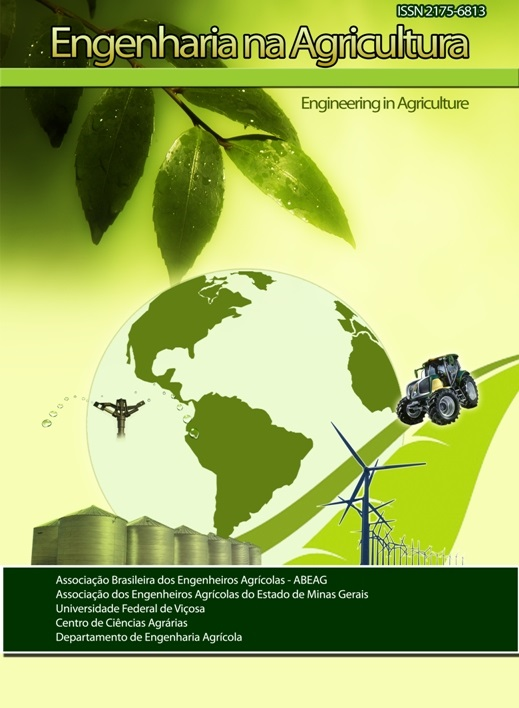INFLUENCE OF TEMPERATURE AND ALTITUDE ON THE EXPANSION OF COFFEE CROPS IN MATAS DE MINAS, BRAZIL
DOI:
https://doi.org/10.13083/reveng.v28i.6360Keywords:
coffea Arabica, coffee cultivation, modeling, MaxEnt, SIG, species distribution.Abstract
Coffee is among the most significant products in Brazil. Minas Gerais is the largest state producer of Arabica coffee. Coffee activity has excellent growth potential, which justifies the identification of new areas for expansion of the culture. This study aimed to determine factors that affect the spatial distribution of coffee plantations the most, as well as to identify areas with a greater aptitude for its expansion in the region of the Matas de Minas (63 municipalities). The MaxEnt software was used to elaborate a model capable of describing the area with the highest potential for estimating the probability of coffee adequacy. The elaboration of the model considered the records of occurrence, climatic and topographic variables of Matas de Minas, the second largest state producing region. The area under the curve (AUC), the omission rate and the Jackknife test were used for validation and analysis of the model. The model was accurate with an AUC of 0.816 and omission rate of 0.54% for the ‘test’. It was identified that the potential distribution of coffee in Matas de Minas is determined by changes in the annual maximum temperature, although it did not generate a significant gain when omitted, accounting for a considerable loss in the model. However, the most influential variables on the delineation of distribution were, the altitude and the annual average temperature. The most favorable areas for expansion of coffee culture in the Matas de Minas were found in the vicinity of the region of Alto Caparaó.
Abbreviations used: A1 (altitude); A2 (maximum annual temperature); A3 (annual minimum temperature); BIO 1 (annual average temperature 1); BIO 4 (temperature seasonality), BIO 12 (annual precipitation); BIO 15 (precipitation seasonality); csv (comma-separated values); AUC (area under the curve).
Downloads
References
ARANDA, Silvia C.; LOBO, Jorge M. How well does presence only based species distribution modelling predict assemblage diversity? A case study of the Tenerife flora. Ecography, v.34, n.1, p.31-38, 2011.
https://doi.org/10.1111/j.1600-0587.2010.06134.x
CAMARGO, M.B.P. The impact of climatic variability and climate change on arabic coffee crop in Brazil. Bragantia, v.69, n.1, p.239-247, 2010. http://dx.doi.org/10.1590/S0006-87052010000100030
COELHO, G.L.N; DE CARVALHO, L.M.T; GOMIDE, L.R. Modelagem preditiva de distribuição de espécies pioneiras no Estado de Minas Gerais. Pesquisa Agropecuária Brasileira, v.51, n.3, p.207-214, 2016.
DOI: 10.1590/S0100-204X2016000300002
CONAB, Companhia Nacional de Abastecimento. Acompanhamento da safra brasileira: café, 4 (4): 1-84, 2017.
ELITH, J.; PHILLIPS S.J.; HASTIE T.; DUDÍK M.; CHEE Y.E., YATES C.J.; A statistical explanation of MaxEnt for ecologists. Diversity and Distributions, 17: 43–57., 2011.
https://doi:10.1111/j.1472-4642.2010.00725.x
Ferreira, W.P., Queiroz, D.M., Silvac, S.A., Tomaz, R.S., Corrêa, P.C. Effects of the Orientation of the Mountainside, Altitude and Varieties on the Quality of the Coffee Beverage from the “Matas de Minas” Region, Brazilian Southeast. American Journal of Plant Sciences, v.7, p.1291-1303, 2016.
http://dx.doi.org/10.4236/ajps.2016.78124
METZ, Charles E. ROC methodology in radiologic imaging. Investigative radiology, v.21, n.9, p.720-733, 1986.
Santana, F.S., De Siqueira, M.F., Saraiva, A.M., & Corrêa, P.L.P. . A reference business process for ecological niche modelling. Ecological informatics, v.3, n.1, p.75-86, 2008.
Santos R.V.M., Vieira H.D., Borem F.M., Prado M.V.B.,. Aplicação de técnicas estatísticas multivariadas em dados de custos da fase de pós-colheita do café. Coffee Science, 12 (2): 223-230, 2017.
Zaidan, Ú.R., Corrêa, P.C., Ferreira, W.P.M., & Cecon, P.R. Ambiente e variedades influenciam a qualidade de cafés das Matas de Minas. Coffee Science, 12 (2): 240-247. 2017.
Downloads
Published
How to Cite
Issue
Section
License
Copyright (c) 2020 REVISTA ENGENHARIA NA AGRICULTURA - REVENG

This work is licensed under a Creative Commons Attribution-NonCommercial 4.0 International License.
Authors who publish with this journal agree to the following terms:
The author(s) authorize(s) the publication of the text in the journal;
The author(s) ensure(s) that the contribution is original and unpublished and that it is not in the process of evaluation by another journal;
The journal is not responsible for the views, ideas and concepts presented in articles, and these are the sole responsibility of the author(s);
The publishers reserve the right to make textual adjustments and adapt texts to meet with publication standards.
From submission, the author is fully conceding the paper's patrimonial rights to the publication, but retaining the owner of its moral rights (authorship and paper's identification) according to Creative Commons Attribution-Noncommercial.








 Licensed by
Licensed by 